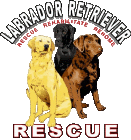Crate Training Your Dog
Crate training is not cruel. It is not inhumane. It is not a bad thing. Crating is a wonderful tool that you can use to train your dog. LRR begins crate training all Labs when they enter our adoption program. We encourage you to continue crate training your adopted Lab.
Labradors are large, social, active dogs who will become destructive if bored and lonely. Crate training is an excellent way to handle this behavior—stopping it before it happens. So many dogs are abandoned at shelters and euthanized because of the repeat damage they caused when left unattended. This is generally the owner’s fault—not the dog’s. Responsible, caring, dog owners use crate training to prevent behavioral and housebreaking problems. Crate training will reduce fear, insecurity, and stress related problems in your rescued dog.
Definition: Crate training is the use of a plastic airline crate or wire cage to confine a pet when the family is not home or is unable to supervise the dog’s activities.
Dogs as Den Animals: Dogs are descended from den animals. Because of this, they feel very safe and secure in small secluded areas. We, as humans, may see the crate as too confining or restrictive. A dog finds a crate a safe, secure haven that is all their own. It is the dog’s bedroom which they will learn to love.
Types of Crates: Crates come in both plastic and wire mesh. The plastic crates are used primarily for airline travel and are sometimes referred to as kennels. The plastic crates do not provide as much ventilation and they do not fold up for easy storage. Wire cages have better ventilation and many of them fold into flat, easy to carry and store cases. The folding crates come with “pin” inserts for the corners or without. The pins are easily lost so you may want to look for the folding crates that do not use them.
Housebreaking Aid: Crates are excellent in housebreaking your dog. Dogs do not like to sleep in their waste, therefore, crating teaches them to “hold it” until they are let outside. You should establish a routine of immediately taking your dog outside to relieve themselves when they are released from their crate. It is not uncommon for recently rescued dogs to have “accidents” in the house because of stress. Using a crate will assist you with this problem. Remember, it is your responsibility to let your dog outside often enough so that they don’t soil their crate.
When to Stop Crating: There is no set age to stop crating your dog. In fact, some dogs will always need the use of a crate. For most dogs, as they pass their adolescence (for Labs, after 3-5 years old), crating can be used less and less until no crating is necessary, except when traveling or during medical recovery periods. It is different for every dog.
Where to Put the Crate: Dogs are social animals and like to be around people, therefore, their crate should also be near people if possible, perhaps in the kitchen, bedroom or den.
Helpful Hints
- The crate must be large enough for the dog to stand and turn around.
- Puppies should not be kept in a crate for more than 3 or 4 hours at a time.
- Adult dogs should not be kept in a crate for more than 8 continuous hours a day.
- Let your dog outside often enough so that it doesn’t have to soil the crate.
- Don’t punish the dog for soiling their crate—it is your responsibility to let them outside often enough so that this doesn’t happen.
- Keep the crate clean and comfortable.
Learning how to crate train your pet can be one of the most beneficial things you can teach your dog. It helps make dog ownership more enjoyable for both you and your dog. It is worth your time to do further research on this topic, to educate yourself how to introduce it to your dog, etc. Additional information on crate training can be found in most training books.
You can also read more about crate training at Wonderpuppy.net.
DISCLAIMER: This article reflects the opinion of LRR, Inc. and should not be considered as professional advice. These articles are not written by professionals, such as veterinarians or behaviorists, but by LRR volunteers. It is always recommended that you seek the advice of a professional for behavior and health issues.





